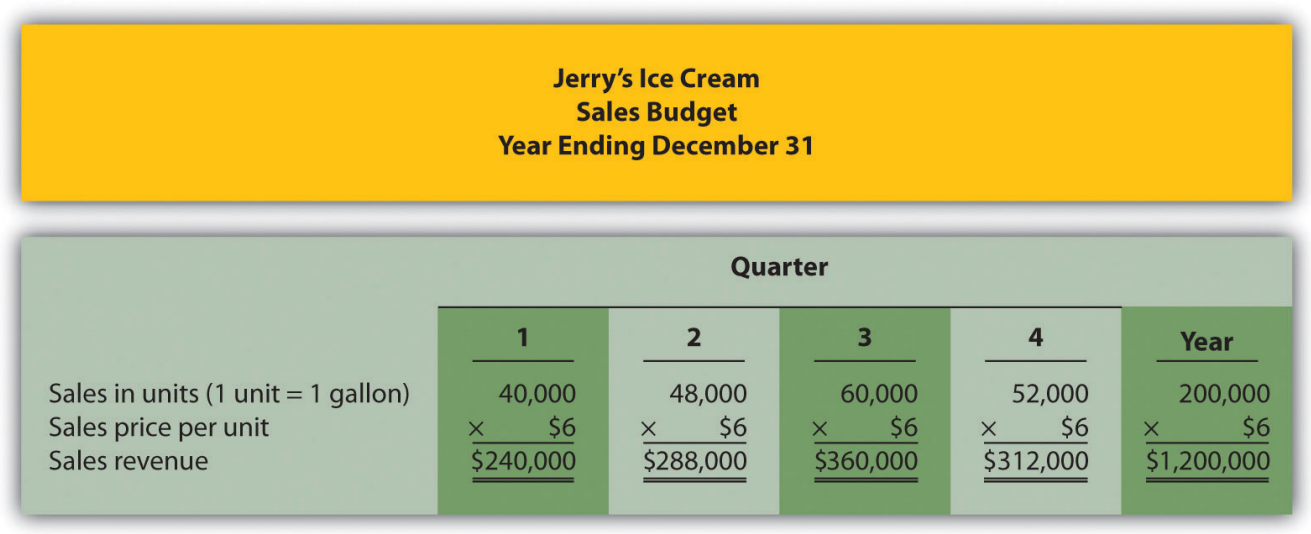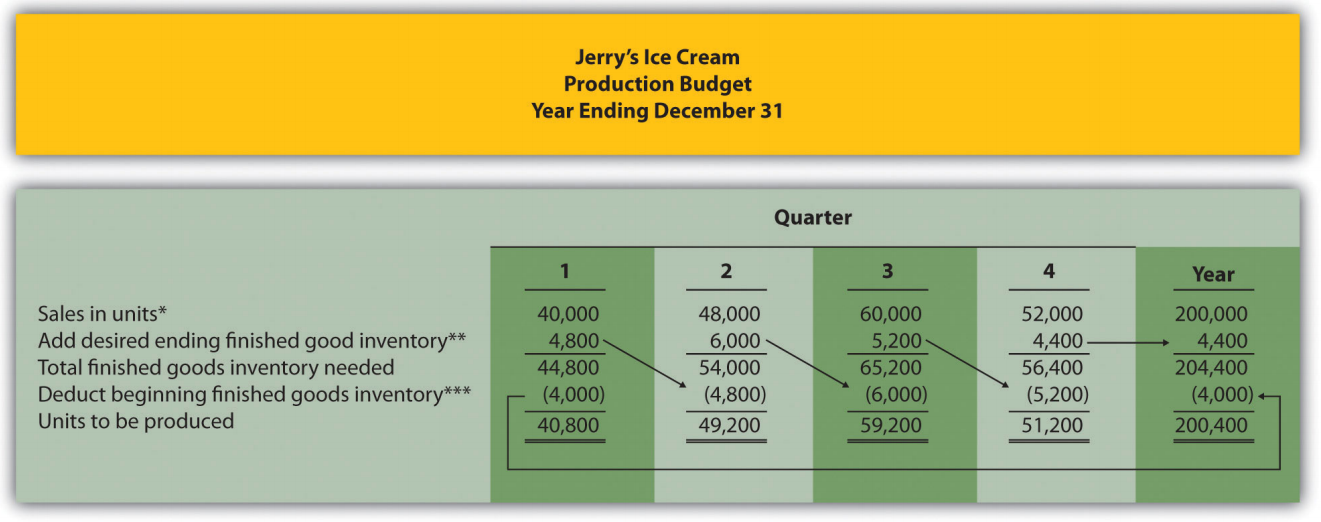92 11.4: The Master Budget (Part 1)
-
Last updated
- Dec 28, 2020
Learning Objectives
- Develop the components of a master budget.
Question: Developing a master budget is a lengthy process. Where do companies start when preparing a master budget?
Sales Budget
Question: The sales budget is the starting point for the master budget, as shown in Figure 9.1. What is a sales budget, and how is it prepared?
- Answer
Tom Benson, sales manager at Jerry’s Ice Cream, talked with his salespeople and reviewed market trends for ice cream using data obtained from a market research firm. His estimate, shown in Figure 11.3, assumes the company will increase sales 15 percent this coming year. Thus, to get projected sales for quarter 1, Tom simply multiplied last year’s first quarter sales by 1.15. The average price per unit last year was $6 (1 unit = 1 gallon), and Tom does not expect any change in this price. The sales budget is presented in Figure 11.3.

Production Budget
Question: The production budget is developed next and is based on sales budget projections. What is a production budget, and how is it prepared?
Jerry’s Ice Cream plans to sell 40,000 units in the first quarter, as shown in Figure 11.3. For the sake of simplicity, assume work-in-process inventory is insignificant, and therefore beginning and ending work-in-process inventory is zero. (We assume beginning and ending work-in-process inventory is zero throughout this chapter.) The management prefers to maintain 10 percent of next quarter’s sales in ending inventory. Thus 4,800 units will be in inventory at the end of the first quarter (= 48,000 unit sales in second quarter × 10 percent). Units needed for the first quarter total 44,800 (= 40,000 unit sales + 4,800 units desired ending inventory). However, Jerry’s will not produce 44,800 units because inventory will be left over from the fourth quarter of last year. This beginning inventory will be 4,000 units (= 40,000 unit sales in first quarter × 10 percent). Thus actual production will total 40,800 units:
Figure 11.4 presents the production budget for each of the 4 quarters of the coming year. Examine this figure carefully, particularly the last line labeled units to be produced. Lynn Young, the production manager, will be concerned about the spike in production during the third quarter of 59,200 units. The third quarter, from July 1 through September 30, is the peak sales season for ice cream. It will be difficult for Lynn to plan for this increase in production from the first and second quarters to the third quarter. However, this is exactly why companies prepare budgets—to plan for the future!

Figure 11.4.4 : – Production Budget for Jerry’s Ice Cream
*Information from Figure 11.3.
**Desired ending inventory = 10 percent × Next quarter sales; for the first quarter, 4,800 = 0.10 × 48,000. Fourth quarter desired ending inventory of 4,400 units is based on an estimate of sales in the first quarter of next year.
***Beginning inventory = Inventory at end of previous quarter; for example, second quarter beginning inventory = First quarter ending inventory.
Once Jerry’s Ice Cream knows how many units it must produce each quarter, budgets are established for the individual components of production: direct materials, direct labor, and manufacturing overhead. We present these budgets next.
Review problem 11.3
Carol’s Cookies produces cookies for resale at grocery stores throughout North America. The company is currently in the process of establishing a master budget on a quarterly basis for this coming fiscal year, which ends December 31. Prior year quarterly sales were as follows (1 unit = 1 batch):
| First quarter | 64,000 units |
| Second quarter | 76,800 units |
| Third quarter | 96,000 units |
| Fourth quarter | 83,200 units |
Unit sales are expected to increase 25 percent, and each unit is expected to sell for $8. The management prefers to maintain ending finished goods inventory equal to 10 percent of next quarter’s sales. Assume finished goods inventory at the end of the fourth quarter budget period is estimated to be 9,000 units.
- Prepare a sales budget for Carol’s Cookies using a format similar to Figure 11.3. (Hint: be sure to increase last year’s unit sales by 25 percent.)
- Prepare a production budget for Carol’s Cookies using the format shown in Figure 11.4.
- Answer
Direct Materials Purchases Budget
Question: The number of units of finished goods to be produced each quarter from the production budget is the starting point for the direct materials purchases budget. What is a direct materials purchases budget, and how is it prepared?
- Answer
Direct Labor Budget
Question: The direct materials purchases budget is the first of three supporting budgets for production. The second is the direct labor budget. What is the direct labor budget, and how is it prepared?
- Answer
Manufacturing Overhead Budget
Question: The manufacturing overhead budget is the third of three supporting production budgets. What is a manufacturing overhead budget, and how is it prepared?
- Answer
Review problem 11.4
Carol’s Cookies, the company featured in the last review problem and in the next three, is now preparing the budget for direct materials purchases, direct labor, and manufacturing overhead.
Each unit of product requires 1.5 pounds of direct materials per unit, and the cost of direct materials is $2 per pound. Management prefers to maintain ending raw materials inventory equal to 30 percent of next quarter’s materials needed in production. Assume raw materials inventory at the end of the fourth quarter budget period is estimated to be 41,000 pounds.
Each unit of product requires 0.20 direct labor hours at a cost of $12 per hour.
Variable overhead costs are:
| Indirect materials | $0.20 per unit |
| Indirect labor | $0.15 per unit |
| Other | $0.35 per unit |
Fixed overhead costs each quarter are:
| Salaries | $28,000 |
| Rent | $22,000 |
| Depreciation | $16,165 |
- Prepare a direct materials purchases budget for Carol’s Cookies using the format shown in Figure 11.5.
- Prepare a direct labor budget for Carol’s Cookies using the format shown in Figure 11.6.
- Prepare a manufacturing overhead budget for Carol’s Cookies using the format shown in Figure 11.7.
- Answer
Definitions
- An estimate of units of product the organization expects to sell times the expected sales price per unit.
- An estimate of units to be produced, and it is based on sales projections plus an estimate of desired ending finished goods inventory less beginning finished goods inventory.
- An estimate of raw materials needed to achieve a desired level of production.
- An estimate of direct labor hours, and related cost, necessary to achieve a desired level of production.
- An estimate of all production costs, other than direct materials and direct labor, necessary to achieve a desired level of production.


